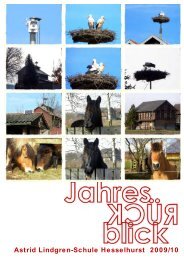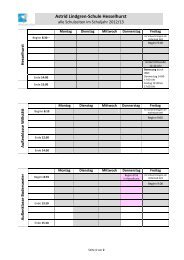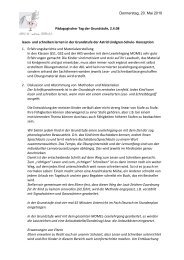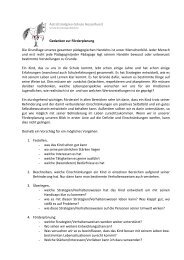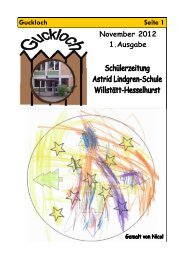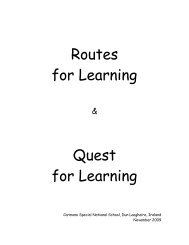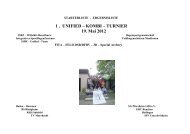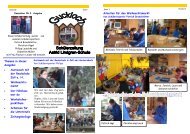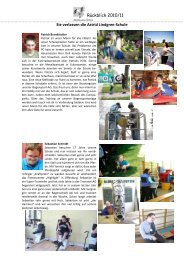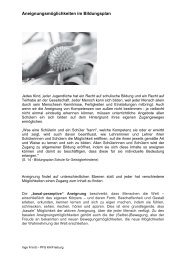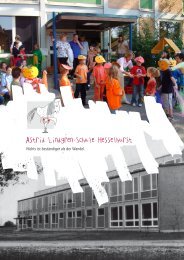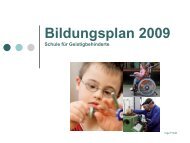Social Networks
Social Networks
Social Networks
Create successful ePaper yourself
Turn your PDF publications into a flip-book with our unique Google optimized e-Paper software.
Per Lorentzen:<br />
A common creative action, where the experience of sharing is<br />
made possible.<br />
Communication happens when:<br />
The student makes an action The communication partner recognize<br />
and confirm the students intention<br />
of communication.<br />
The student receive this<br />
as confirmation<br />
and when
(From social networks‘ manual)<br />
<strong>Social</strong> networks for professionals who are engaged<br />
to advise on and teach AAC(augmentative and<br />
alternative communication). The material may also<br />
be of interest to professionals and caregivers who<br />
use AAC in their interaction with people with<br />
disabilities.<br />
The material was released in the U.S. in 2003 and<br />
was developed by doctoral Sarah W. Blackstone and<br />
Mary Hunt Berg, Ph.D., in collaboration with the<br />
Berkeley Study Group.
<strong>Social</strong> networks are tools that make it possible to<br />
gather knowledge on a number of necessary areas<br />
where you have to advise people with disabilities<br />
about what kinds of AAC will be appropriate to use.<br />
<strong>Social</strong> <strong>Networks</strong> are characterized by the person in<br />
need of AAC communication, and its closest is at the<br />
center to gather information and plan the<br />
educational effort, since the person's own<br />
perspective involved as much as possible.
A major basis of the material mapping of whom<br />
the individual communicates with in his or hers<br />
life. What he or she communicates about or<br />
want to communicate to its various<br />
communication partners.
In <strong>Social</strong> <strong>Networks</strong> also includes an assessment<br />
of language and related skills. This score puts<br />
great emphasis on clarifying what has formed the<br />
basis for assessment.
Circles with communication partners:
CIRCLE ONE:<br />
Person's lifetime communication partner. The first<br />
circle includes family members and others for which<br />
the person lives with or is a family member.<br />
CIRCLE TWO:<br />
Close friends / relatives.The second circle<br />
represents the people, that person spends leisure<br />
time with, share interests with, play with and<br />
confides in.
CIRCLE THREE:<br />
Acquaintances. This circle includes people who<br />
know the person, but he has no regularly<br />
socialize with.<br />
CIRCLE FOUR:<br />
Professionals. Here, it is generally people who<br />
are paid to be with that person.
CIRCLE FIVE:<br />
Persons unknown: The fifth circle represents "all<br />
others". There is no talk about specific people,<br />
but a category of people who could be potential<br />
communication partners.<br />
Over time and through a person's life, the circle<br />
of communication partners can change. When a<br />
person's circle change, the same will be true for<br />
their communications needs and AAC - systems.
Types of communications.<br />
Dawning of communication:<br />
Expresses itself not symbolic.<br />
Uses; body language, gestures, vocalizations and<br />
non-symbolic ways of communication.<br />
Can communicate yes/no for accept/rejection,<br />
but no use of yes/no signals beyond the<br />
immediate context.
contextual communication:<br />
Efficient symbolic communication, but limited to specific<br />
contexts or partners, for two reasons: some speak<br />
incomprehensible - use special communication<br />
strategies, the other can only communicate in limited<br />
contexts, because they do not have an adequate or<br />
appropriate vocabulary.<br />
Depending on others to choose and pre-program their<br />
vocabulary.<br />
Addicted to familiar communication partners to help to<br />
be understood or to have the right vocabulary.
Independent Communications:<br />
Eligible for the interaction of known and<br />
unknown partners on any topic in any context<br />
Can typically read and write.<br />
can generate new messages independently
How to use <strong>Social</strong> <strong>Networks</strong>:<br />
<strong>Social</strong> <strong>Networks</strong> is a debate and planning tool<br />
that enables professionals to collect and<br />
interpret important information which may<br />
influence the yield of AAC - actions.<br />
Who participates in the process:<br />
one person in the first circle.<br />
one person in the fourth circle.<br />
the person who uses AAC, whenever possible.
How to use <strong>Social</strong> <strong>Networks</strong><br />
Preconditions for communication<br />
Communication partners<br />
Express ways<br />
Forms of representation<br />
Selection techniques<br />
Strategies that support interaction<br />
Conversation topics<br />
Type of communication
Wishes and needs in relation to communication<br />
Conclusion<br />
Recommendations
I believe, when I see it<br />
I see it, when I believe



